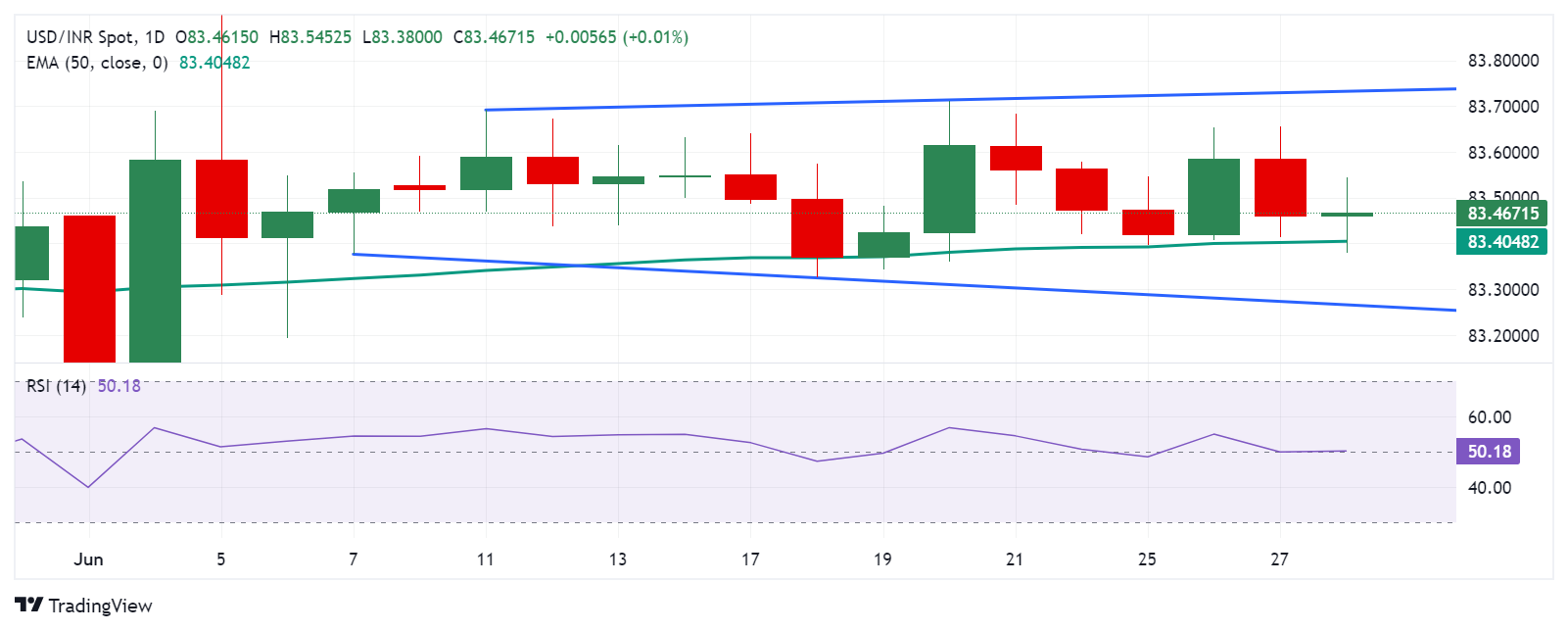- The Indian Rupee extended gains on expected foreign inflows following the bonds’ inclusion in the JP Morgan Emerging Markets Bond Index.
- Indian equity markets are appreciating due to return of foreign institutional investors and increased buying in index heavyweights.
- The US core PCE will be released on Friday, expected to decline year-on-year to 2.6% from 2.8% previously.
The Indian Rupee (INR) extends its gains for the second consecutive session during Asian hours, which could be attributed to expectations of foreign flows. Indian bonds are set to enter the JP Morgan Emerging Markets (EM) Bond Index on Friday.
Indian equity markets extend gains on return of foreign institutional investors and increased buying in index heavyweights, amid strong economy and prospects for policy continuity.
Indian Rupee traders are likely to watch key economic data on Friday, including the Federal Fiscal Deficit for May and Foreign Exchange Reserves for the week ending June 17.
As for the US Dollar (USD), the core Personal Consumption Expenditures (PCE) Price Index inflation is projected to slow year-over-year to 2.6% from 2.8% previously. This data is considered the preferred inflation indicator by the Federal Reserve (Fed).
Daily Digest Market Movers: Indian Rupee Extends Gains on Foreign Flows
- Foreign investors have already invested approximately $10 billion in securities eligible to join JPMorgan’s index, according to Business Standard. Meanwhile, Goldman Sachs anticipates at least $30 billion more in flows in the coming months as India’s weight in the index gradually increases to 10%.
- Federal Reserve Board of Governors Michelle Bowman said Thursday that she is not yet ready to support a central bank rate cut with inflation pressures still high. Bowman said, adding “We are not yet at the point where it is appropriate to lower the policy rate, and I continue to see a number of upside risks to inflation,” according to Reuters.
- US Annualized Gross Domestic Product expanded 1.4% in the first quarter, slightly higher than the previous reading of 1.3%, but continuing to point to the weakest growth since contractions in the first half of 2022 .
- U.S. Initial Claims for Jobless Benefits showed on Thursday that the number of people claiming unemployment benefits fell to 233,000 in the week ending June 21, below market expectations of 236,000. The claim count fell for a second straight week since hitting a 10-month high of 243,000 in early June.
- The first US presidential debate between President Joe Biden and Republican presidential nominee Donald Trump began on CNN News. Biden acknowledged that “inflation had pushed prices substantially higher than at the start of his term, but said he deserves credit for ‘building things back’ in the wake of the coronavirus pandemic.” In response, Trump condemned high levels of inflation. He suggested tariffs would reduce deficits and urged looking at countries like China, according to Reuters.
- S&P Global Ratings maintained its growth forecast for India at 6.8% for fiscal 2025, citing high interest rates and government spending boosting demand in non-farm sectors.
- On Tuesday, RBI Governor Shaktikanta Das said India is on the verge of a major structural shift in its growth trajectory, moving towards sustained GDP growth of 8%. Das attributes this growth to several key factors, including structural reforms such as the Goods and Services Tax (GST), as reported by The Economic Times.
Technical Analysis: USD/INR falls below 83.50
USD/INR is trading around 83.40 on Friday. Analysis of the daily chart shows a widening pattern, suggesting a possible correction before a move lower. The 14-day Relative Strength Index (RSI) is below the 50 level, indicating a bearish bias.
The USD/INR pair is testing the immediate support at the 50-day Exponential Moving Average (EMA) of 83.40. A break below this level could potentially strengthen the bearish bias, which could lead the pair towards the lower boundary of the broadening pattern, around the 83.30 level.
Upside resistance is anticipated near the upper boundary of the widening formation, around 83.70, followed by the psychological level of 84.00.
USD/INR: Daily Chart
US Dollar PRICE Today
The table below shows the percentage change of the US Dollar (USD) against major currencies today. US dollar was the weakest currency against the Indian rupee.
| USD | EUR | GBP | JPY | CAD | AUD | NZD | INR | |
|---|---|---|---|---|---|---|---|---|
| USD | 0.16% | 0.13% | 0.16% | 0.22% | 0.36% | 0.37% | 0.03% | |
| EUR | -0.16% | -0.03% | 0.00% | 0.06% | 0.20% | 0.21% | -0.13% | |
| GBP | -0.13% | 0.03% | 0.00% | 0.07% | 0.22% | 0.24% | -0.11% | |
| JPY | -0.16% | 0.00% | 0.00% | 0.03% | 0.19% | 0.19% | -0.13% | |
| CAD | -0.22% | -0.06% | -0.07% | -0.03% | 0.13% | 0.15% | -0.18% | |
| AUD | -0.36% | -0.20% | -0.22% | -0.19% | -0.13% | 0.01% | -0.33% | |
| NZD | -0.37% | -0.21% | -0.24% | -0.19% | -0.15% | -0.01% | -0.34% | |
| INR | -0.03% | 0.13% | 0.11% | 0.13% | 0.18% | 0.33% | 0.34% |
The heat map shows percentage changes for major currencies. The base currency is selected from the left column, while the quote currency is selected from the top row. For example, if you choose the US Dollar from the left column and move along the horizontal line to the Japanese Yen, the percentage change shown in the box will represent USD (base)/JPY (quote).
Indian Rupee FAQs
The Indian Rupee (INR) is one of the currencies most sensitive to external factors. The price of crude oil (the country relies heavily on imported oil), the value of the US Dollar (most trade is done in US dollars), and the level of foreign investment are all influential factors. The direct intervention of the Reserve Bank of India (RBI) in the foreign exchange markets to keep the exchange rate stable as well as the level of interest rates set by the RBI are other important factors influencing the Rupee. .
The Reserve Bank of India (RBI) actively intervenes in foreign exchange markets to maintain a stable exchange rate and help facilitate trade. Furthermore, the RBI tries to keep the inflation rate at its target of 4% by adjusting interest rates. Higher interest rates tend to strengthen the Rupee. This is due to the role of the “carry trade”, in which investors borrow in countries with lower interest rates to park their money in countries that offer relatively higher interest rates and profit from the difference.
Macroeconomic factors that influence the value of the Rupee include inflation, interest rates, economic growth rate (GDP), trade balance and foreign investment inflows. A higher growth rate can lead to more investment abroad, increasing demand for the Rupee. A less negative trade balance will eventually lead to a stronger Rupee. Higher interest rates, especially real rates (interest rates minus inflation) are also positive for the Rupee. A risk environment can lead to higher inflows of foreign direct and indirect investment (FDI and FII), which also benefit the Rupee.
Higher inflation, particularly if it is comparatively higher than other countries, is generally negative for the currency as it reflects a devaluation through excess supply. Inflation also increases the cost of exports, leading to more rupees being sold to buy foreign imports, which is negative for the Indian Rupee. At the same time, higher inflation usually leads the Reserve Bank of India (RBI) to raise interest rates and this can be positive for the Rupee, due to increased demand from international investors. The opposite effect applies to lower inflation.
Source: Fx Street
I am Joshua Winder, a senior-level journalist and editor at World Stock Market. I specialize in covering news related to the stock market and economic trends. With more than 8 years of experience in this field, I have become an expert in financial reporting.








